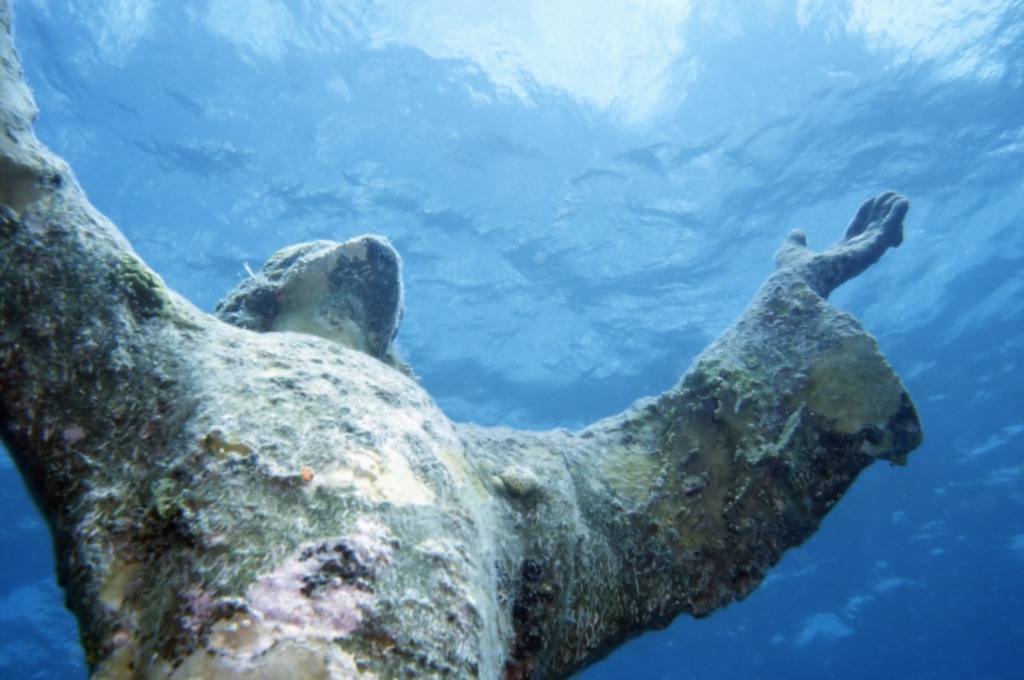“Last-chance tourism” hastens decline of destinations threatened by global warming, like the Florida Reef and the Galapagos Islands

By Aditi Shrikant
18 March 2019
(Vox) – Plopped in the Florida Reef is a 4,000-pound bronze Jesus named Christ of the Abyss. The statue is one of the most photographed sites in the Florida Keys, and at Lobster Trap Art you can buy his portrait printed on ceramic tiles for $24.
Like many of the products at this local photography shop, pictures of Christ of the Abyss look almost photoshopped — Jesus being circled by tropical fish, a sea turtle, and a shark.
But Lobster Trap Art owner Glenn Lahti says that when he moved to the Keys 27 years ago, the beauty was even more surreal: “The water was clearer, there were more fish and even more coral.”
Home to the only tropical coral reef in the continental United States, Monroe County, which includes the Florida Keys and Everglades National Park, rakes in $2.7 billion a year in tourism, much of it from those coming to see its national treasure. However, the city’s tourism-dependent economy has put the region in jeopardy, as travelers may also be killing the area’s biggest asset; Lahti’s is one of many businesses in the Keys that simultaneously profit from and are threatened by travelers.
Today, the net effect of human traffic and its hand in climate change have done possibly irreparable damage to the landmark. When confronted with direct contact from humans or reef-damaging sunscreen chemicals, corals experience stress, leading to coral bleaching. And this isn’t the only issue; the carbon footprint involved in travel also has a deleterious effect on the reef.
The cloud of destruction that looms over the Keys hovers over many tourist destinations affected by climate change: the Great Barrier Reef, the Galapagos, Montana’s National Glacier Park. And in recent years, these sites’ anticipated disappearance has been a large part of their draw. Labeled “last-chance tourism,” this is the practice of visiting a location before it vanishes or is irreparably changed.
As climate change worsens, last-chance tourism grows
When Canadian researchers started exploring last-chance tourism almost a decade ago, they faced backlash from scientists who feared this term was too alarmist, according to E&E News, a news organization focused on energy and climate. But with 71 percent of the American population now agreeing that climate change is real, the term last-chance tourism is more statement than prediction.
Their 2010 study, done in Churchill, Manitoba, a city that offers dozens of tours of the dwindling polar bear population, found that the increasing vulnerability of polar bears motivated a majority of visitors to travel there. Sixty percent of visitors said they would still want to see polar bears even if they looked emaciated, and 71 percent said that if the polar bear population in Churchill were destroyed, they would simply go somewhere else to view them.
Since its introduction, the phenomenon has been identified at other destinations. In a 2016 study of the Great Barrier Reef, researchers found that almost 70 percent of visitors wanted to visit the reef “before it was gone.” For $1,500, tourists go gorilla trekking in Rwanda’s Volcanoes National Park, which houses 880 of the 100,000 to 200,000 gorillas left in the world. Lauren Alley, a representative from National Glacier Park, told E&E that many visitors tell her they want to see the glaciers before they melt away. In the mid-1800s, the park had 150 glaciers; only 26 are left. [more]
Tourists are flocking to locations threatened by climate change. That only makes things worse.